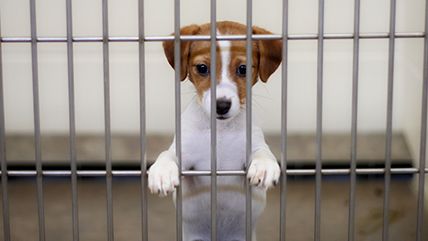Helicopter Parenting for Pet Owners

When Lisa Weiss and her family decided to adopt a dog a few years ago, they contacted a rescue organization near their home in Chappaqua, New York, and were told to fill out a form.
"It was, like, 20 pages!" Weiss, a lawyer, recalls. "It took me an hour. I was very honest and very detailed because I was pretty proud of what great pet parents we are. I thought we were fantastic. We had a Lab rescue who had lived to 13, which was well past her sell-by date. She died of old age, no illnesses. She was a happy, outside dog. We had an electric fence and she came and went as she pleased. She was a completely independent soul."
Right on—free-range!
And yet there was still more information the form demanded. "It also asked things like 'Who will take the dog if you die?'" recalls Weiss. "And 'If you both die, who takes the dog?'" Slightly freaked out, she nominated her sister-in-law.
When all her ts were crossed, she submitted the paperwork and waited to hear back from the rescuers.
And waited. And waited.
Finally, she called to ask what was taking so long "and they were like, 'Oh, we rejected you.'"
The problem, they said, was that Weiss planned to allow her dog to be outside unsupervised…and he might get stolen.
And there you have it: proof that as go kids, so go pets. Not only are human children barely allowed to walk by themselves from the house to the bus stop, but pets aren't allowed to play by themselves in a merely electric-fenced yard.
Debra Caruso Marrone, a publicist on Long Island, insists she truly appreciated the rescue organization she was dealing with: "They were very nice people." And yet, she says, "To get a dog you fill out a questionnaire: Are you home during the day? Do you work? What time do you come home?" It sounded as if only stay-at-home parents would be good enough.
They also wanted to know if there were other dogs in Caruso Marrone's extended family. "We told them yes, our daughter and her husband have a dog." The rescue folks told her that the dog she wanted had a history of not getting along with other animals, so they were giving him to her—on probation. "They asked us to take pictures of our newly adopted dog interacting with our daughter's dog, because they weren't convinced the two could coexist."
Caruso Marrone found herself in the strange situation of arranging a puppy playdate and staging a photo shoot—but it did the trick. She got to keep the dog, who later became good friends with her daughter's pup.
Two decades ago, Amanda Uhry, president of Manhattan Private School Advisors, a consulting service, adopted her daughter from China. Recently, she tried to adopt a dog from a local rescue. "The only parallel I can see is that human adoption appears to be easier," she says.
To adopt her daughter, Uhry had to pass a home inspection and be interviewed and fingerprinted. To take in a needy poodle? "They were like, 'Do you have a dog walker? Who's going to be the vet? What kind of classes are you going to take your dog to?'"
She did not get a dog.
No doubt there are bad people out there who mistreat animals. That is shameful. But the vetting process, as it were, is following the trajectory of most bureaucracies—piling on more and more rules with little thought as to whether they're actually improving the situation or even doing the opposite: driving potential pet parents away in frustration. "It's easier to get into the Pentagon," one would-be adopter seethed to me.
A chef in Southern California who didn't want to give her name for fear of ruffling any fur went to a rescue center whose rules stated, for some reason, that its dogs could only go to people within 15 miles. "They wouldn't adopt to me because I was 15.2 miles away," she says. "I Google mapped it. I said, 'I love your dogs. I want to get a dog from you guys!' And they were like, 'You're out of the 15-mile radius.'" Sorry, ma'am, just following the rules.
She ended up buying a dog from a breeder.
This article originally appeared in print under the headline "Helicopter Parenting for Pet Owners."
Show Comments (10)